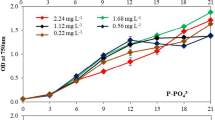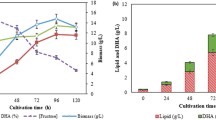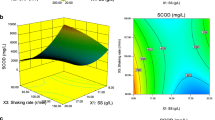Abstract
To study the effect of agitation speed (rpm) and dissolved oxygen concentration (DO) on the production of gamma linolenic acid by Mucor sp. RRL001, a central composite design experiment was performed in a 5-L stirred tank bioreactor. The design consisted of a total of 10 runs consisting of runs at five levels for each factor and was divided in two blocks. The ANOVA analysis and Pareto chart of effects suggested agitation speed (p = 0.0142) linear effect and DO concentration (p = 0.0342) quadratic effects were significant factors with significant contribution to the response. The validation run based on the optimum production zone in response surface plot resulted in the maximum 350.3 mg l−1 GLA yield as compared with model predicted value of 340.7 mg l−1. The study suggests that agitation rate is having more pronounced effect on GLA yield than dissolved oxygen concentration by ensuring enhanced mass transfer and by preventing wall growth at elevated agitation speed. Also, it shows that higher GLA yields can be obtained in a simple medium at moderate oxygen saturation and that the Mucor sp. RRL001 is resistant to high agitation linked shear stress and suitable for GLA production at higher scale.


Similar content being viewed by others
References
Das, U. N. (2007). A defect in the activity of D6 and D5 desaturases may be a factor in the initiation and progression of atherosclerosis. Prostaglandins Leukotrienes and Essential Fatty Acids, 76, 251–268.
Fan, Y. Y., & Chapkin, R. S. (1998). Recent advances in nutritional science—Importance of dietary g-linolenic acid in human health and nutrition. Journal of Nutrition, 128, 1411–1414.
Fan, Y. Y., Ramos, K. S., & Chapkin, R. S. (1995). Dietary g-linolenic acid modulates macrophage-vascular smooth muscle cell interactions: evidence for a macrophage-derived soluble factor that down regulates DNA synthesis in smooth muscle cells. Arteriosclerosis, Thrombosis, and Vascular Biology, 15, 1397–1403.
Zurier, R. B., Rossetti, R. G., Jacobson, E. W., DeMarco, D. M., Liu, N. Y., Temming, J. E., White, B. M., & Laposata, M. (1996). Gamma-linolenic acid treatment of rheumatoid arthritis: a randomized, placebo-controlled trial. Arthritis and Rheumatism, 39, 1808–1817.
Uauy, R., & Mena, P. (1999). Requirements for long-chain polyunsaturated fatty acids in the preterm infant. Current Opinion Pediatrics, 11, 115–120.
Box, G. E. P., Hunter, J. S., & Hunter, W. G. (2005). Statistics for experimenters (2nd ed.). New York: Wiley-Interscience.
Bruns, R. E., Scarminio, I. S., & Neto, B. B. (2006). Statistical design—Chemometrics. Elsevier: Amsterdam.
Zheng, Z. M., Hu, Q. L., Hao, J., Xu, F., Guo, N. N., Sun, Y., & Liu, D. H. (2007). Statistical optimization of culture conditions for 1,3-propanediol by Klebsiella pneumoniae AC 15 via central composite design. Bioresource Technol, 99(5), 1052–1056.
Gupta, N., Sahai, V., & Gupta, R. (2007). Alkaline lipase from a novel strain Burkholderia multivorans: statistical medium optimization and production in a bioreactor. Process Biochemistry, 42, 518–526.
Muralidhar, R. V., Chirumamila, R. R., Marchant, R., & Nigam, P. (2001). A response surface approach for the comparison of lipase production by Candida cylindracea using two different carbon sources. Biochemistry Engineering Journal, 9, 17–23.
Ahmed, S. U., Singh, S. K., Pandey, A., Kanjilal, S., & Prasad, R. B. N. (2006). Effects of various process parameters on the production of γ–Linolenic acid in submerged fermentation. Food Technology and Biotechnology, 44, 283–287.
Folch, J., Less, M., & Stanley, S. (1957). A simple method for the isolation and purification of total lipids from animal tissues. Journal of Biological Chemistry, 226, 497–509.
Morrison, W. R., & Smith, L. M. (1964). Preparation of fatty acid methyl esters and dimethylacetals from lipids with boron fluoride- methanol. Journal of Lipid Research, 53, 600–608.
Bernardo, O., Santisteban, Y. S., & Filho, F. M. (2005). Agitation, aeration and shear stress as key factors in inulinase production by Kluyveromyces marxianus. Enzyme and Microbial Technology, 36, 717–724.
Hiruta, O., Futumara, T., Takebe, H., Satoh, A., Kamisaka, Y., Yokochi, T., Nakahara, T., & Suzuki, O. (1996). Optimization and scale-up of γ-Linolenic acid production by Mortriella ramanniana MM 15-1, a high γ -Linolenic acid producing mutant. Journal of Fermentation and Bioengineering, 82, 366–370.
Certik, M., Balteszova, L., & Sajbidor, J. (1997). Lipid formation and gamma-linolenic acid production by Mucorales fungi grown on sunflower oil. Letters in Applied Microbiology, 25, 101–5.
Tauk-Tornisielo, S. M., Vieira, J. M., Cecilia, M., Carneiro, V. S., & Govone, J. S. (2007). Fatty acid production by four strains of Mucor hiemalis grown in plant oil and soluble carbohydrates. African Journal of Biotechnology, 6, 1840–1847.
Ward, O. P., & Singh, A. (2005). Omega-3/6 fatty acids: alternative sources of production. Process Biochemistry, 40, 3627–3652.
Acknowledgments
One of the authors, Syed Ubaid Ahmed, thanks CSIR, New Delhi, India, for SRF fellowship. The proposed work was financially supported by CSIR TASK FORCE CMM006 grant.
Author information
Authors and Affiliations
Corresponding author
Rights and permissions
About this article
Cite this article
Ahmed, S.U., Singh, S.K., Pandey, A. et al. Application of Response Surface Method for Studying the Role of Dissolved Oxygen and Agitation Speed on Gamma-Linolenic Acid Production. Appl Biochem Biotechnol 152, 108–116 (2009). https://doi.org/10.1007/s12010-008-8256-6
Received:
Accepted:
Published:
Issue Date:
DOI: https://doi.org/10.1007/s12010-008-8256-6




